This post may contain affiliate links. Please read our disclosure policy.
Learn how to make Xi’an hand-pulled long, flat, and wide wheat noodles. They are easier to make than you think and so delicious when you toss them in this simple savory, spicy, tangy, umami sauce.

What is biang biang noodle?
The name biang biang comes from the sound that it makes when slapping the dough on the countertop while pulling the noodles long and wide. You will hear the “biang…biang” sound. This biang biang noodles are originated in the city of Xi’an. It’s been around for thousands of years. Because of the wide and flat shape, some call it the belt noodles, because it shapes like a belt. The noodles are thick and chewy and usually served in savory, spicy, tangy and umami sauce. Some may add a protein like minced meat, tofu, etc to make it a complete meal. Otherwise, it can be a perfect side dish too.
It’s easy but it takes time to make (passive time)
Just to set your expectation from the beginning 😉 This biang biang noodle is easy to make, BUT, it needs time. Most of the time is pretty much resting the dough, which is passive waiting time. The resting allows the dough to be stretched and pulled without breaking. So you cannot skip the resting part.
You only need 3 ingredients to make biang biang noodle
The noodle dough only needs 3 ingredients:
1. All-purpose flour
I use all-purpose flour with a gluten content of about 11.7%. I don’t recommend using bread flour as it will make the noodle difficult to pull due to the higher gluten content.
2. Salt
You just need a pinch of salt here. It provides flavor and also help to strengthen the gluten structure
3. Water
Room temperature water is used to prepare the dough

How to prepare the dough for biang biang noodles
You need very minimal kneading to prepare the dough and no machine is needed.
1. Combine all-purpose flour, salt, and water. Stir with a chopstick/spatula at first into crumbly dough and then knead with your hand just to form a rough dough



2. Cover and let the dough rest for 20 minutes. This is a short autolyse process. We hydrate the flour and let it rests to let the enzyme starts the gluten formation process. It’s magical really!

3. Go back to knead the dough for about 1-2 minutes by hand and you will see the dough transform into a smooth dough (thanks to the autolyse)
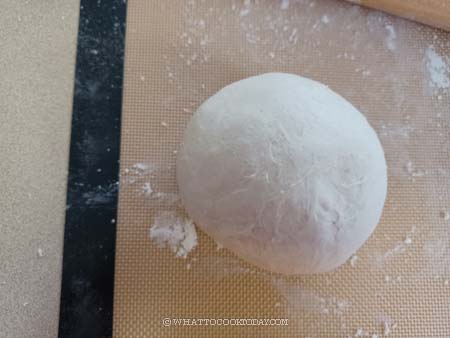
4. Divide the dough into 6 pieces. Fold the edge of each dough into center and then put it on counter top, seam side down with your palm on top and roll it into a round ball. Repeat with the rest

5. Cover with a damp towel or plastic wrap and let them rest for another 15 minutes. This is to relax the gluten (after all that rolling)

6. Roll the dough out into an oval shape, roughly about 6-7 inch in length. Then use a chopstick or a skewer to create an indentation in the middle. Repeat with the rest
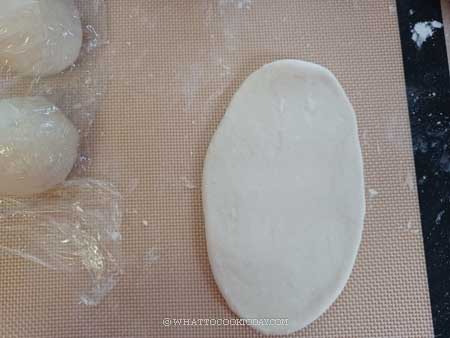


7. Coat each dough with some oil and put on a plate. Cover and let them rest for 2 hours. It is important to let them rest this long


How to pull and shape biang biang noodles
1. Bring a large pot of water to a boil while you start working on the dough
2. Work with one dough at a time. Hold the dough on each end and slowly pull it to about 10 inches or more and then slap the dough on the countertop several times as you continue to gently pull(you will hear the “biang biang” sounds, hence the name!). The slapping helps you to stretch the noodles
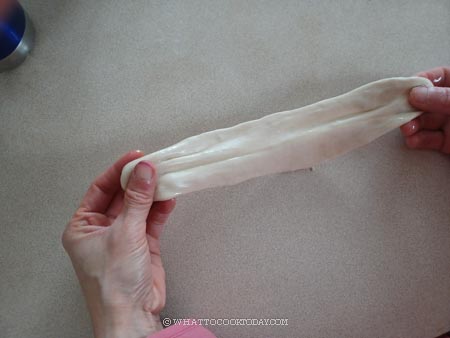

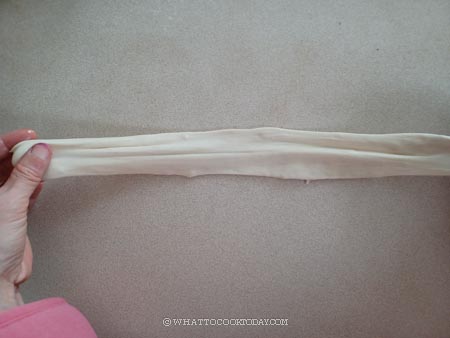

3. Then start from the middle and rip the noodle apart, following the indentation you made with the chopstick/skewers earlier. Now you have these belt-shaped noodles. Continue with the rest of the dough



How to cook biang biang noodles
1. When the water comes to a boil, add the pulled noodles and stir a bit to prevent the noodles from sticking to the bottom of the pot. Cook for about 1 minute. Do not overcook them

2. Transfer the noodles to a large serving bowl. Do not rinse with water as we want the sauce to cling to the noodles
How to prepare the sauce
The tossing sauce is savory, spicy, tangy, and umami.
1. Combine the soy sauce, black vinegar, chili powder, sugar, minced garlic, chopped scallion, and salt in a heat-proof bowl
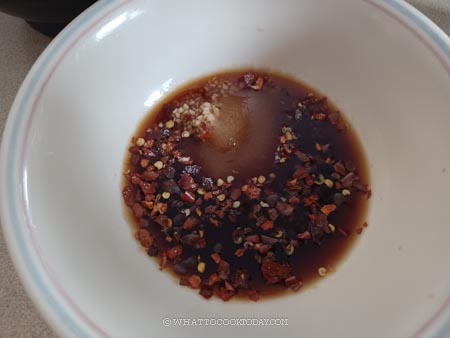
2. Heat about 3 Tablespoons of oil until it is really hot. Carefully pour this hot oil over into the bowl with all the ingredients you prepare earlier. This really brings out the flavor of the sauce


4. Pour this over the cooked biang biang noodles and toss to make sure the sauce coats the noodles evenly

This biang biang noodle are so delicious. I love the rustic look and the chewy noodles.

How to prepare the dough ahead
1. You can prepare the dough up to the part where we rest it for 2 hours. But instead of resting it for 2 hours, you let it rests in the fridge overnight
2. When you are ready to use the dough, let it comes to room temperature before you pull the noodles, this may take 2-3 hours. You don’t want to pull the cold dough as it won’t be elastic
Did you make this Xi’an biang biang noodle recipe?
I love it when you guys snap a photo and tag to show me what you’ve made 🙂 Simply tag me @WhatToCookToday #WhatToCookToday on Instagram and I’ll be sure to stop by and take a peek for real!

Easy Xi'an Biang Biang Noodles (Belt Noodles)
Ingredients
Dough:
- 200 gr all-purpose flour
- 1 gr salt
- 100 ml water
For the sauce: (the amount is just for reference, please adjust to your taste)
- 1 Tbsp soy sauce
- 1 Tbsp Chinese black vinegar
- 1 tsp chili powder please adjust to your preference
- 1 tsp sugar
- 2 tsp minced garlic
- 1 stalk green onion
- 3 Tbsp oil plus more to brush on the dough
Instructions
Prepare the dough:
- Combine all-purpose flour, salt, and water. Stir with a chopstick at first into crumbly dough and then knead with your hand just to form a rough dough
- Cover and let the dough rest for 20 minutes. This is a short autolyse process. We hydrate the flour and let it rests to let the enzyme starts the gluten formation process. It’s magical really!
- Go back to knead the dough for about 1-2 minutes by hand and you will see the dough transform into a smooth dough (thanks to the autolyse)
- Divide the dough into 6 pieces. Fold the edge of each dough into center and then put it on countertop, seam side down with your palm on top and roll it into a round ball. Repeat with the rest
- Cover with a damp towel or plastic wrap and let them rest for another 15 minutes. This is to relax the gluten (after all that rolling)
- Roll the dough out into an oval shape, roughly about 6-7 inch in length. Then use a chopstick or a skewer to create an indentation in the middle. Repeat with the rest. Coat each dough with some oil and put on a plate. Cover and let them rest for 2 hours. It is important to let them rest this long
- You can also rest them longer such as overnight in the fridge. Let them sit at room temperature for few hours before pulling
Pull and shape:
- Bring a large pot of water to a boil while you start working on the dough. Work with one dough at a time. Hold the dough on each end and slowly pull it to about 10 inches or more and then slap the dough on the countertop several times as you continue to gently pull(you will hear the “biang biang” sounds, hence the name!). The slapping helps you to stretch the noodles
- Then start from the middle and rip the noodle apart, following the indentation you made with the chopstick/skewers earlier. Now you have these belt-shaped noodles. Continue with the rest of the dough
Cook the noodles:
- When the water comes to a boil, add the pulled noodles and stir a bit to prevent the noodles from sticking to the bottom of the pot. Cook for about 1 minute. Do not overcook them
- Transfer the noodles to a large serving plate. Do not rinse with water as we want the sauce to cling to the noodles
Prepare the sauce:
- Combine the soy sauce, black vinegar, chili powder, sugar, minced garlic, chopped scallion, and salt in a heat-proof bowl
- Heat about 3 Tablespoons of oil until it is really hot. Carefully pour this hot oil over into the bowl with all the ingredients you prepare earlier. This really brings out the flavor of the sauce
To serve:
- Pour this over the cooked biang biang noodles and toss to make sure the sauce coats the noodles evenly. Serve

6 comments
Hi
Can we use Yang Chun Mian for this? Thanks
Hi, yes, the tossing sauce can be used with pretty much any noodles 🙂
Hello! can Luhua Chinese Wide Flat Noodles also be used for the Easy Xi’an Biang Biang Noodle recipe? Can you give me the names of other Biang Biang noodles that I can use as a substitute noodle for the Chinese Belt Noodles?
Hi Gloria, that should work too! I have also tried it with this Dao Xiao Mian (knife-cut noodles) https://amzn.to/3vRjmxn You can use any brand, just to show you the noodles.
I love biangbiang noodles, and make them a lot. I decided to try your recipe for the sauce and boy oh boy I did I learn a lesson—I thought a tablespoon of chilli powder seemed like a lot, so I used more like 1 teaspoon, but even that was crazy hot. I think you might have meant to use chilli flakes instead…
I actually used chili powder, and I’m glad you brought this up because it is supposed to be 1 tsp and not 1 Tbsp, my typing error! Sorry that it’s too spicy for you.